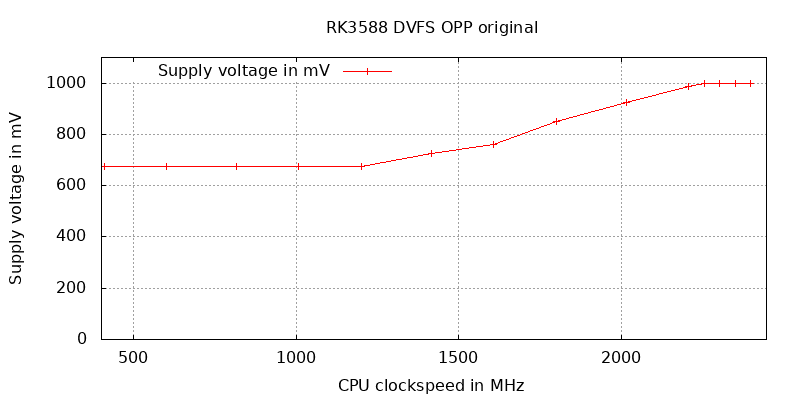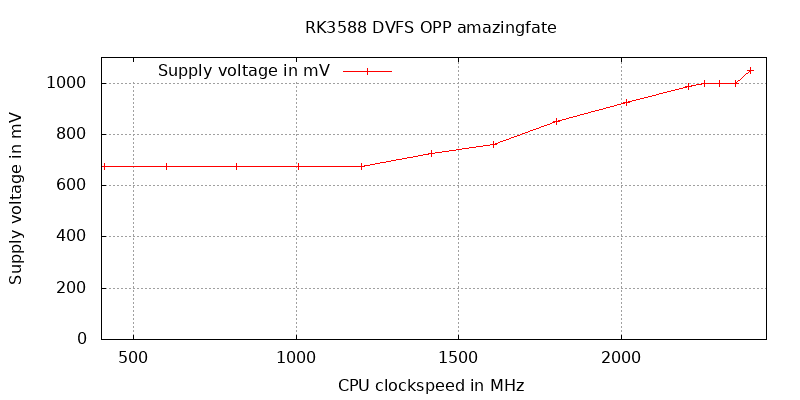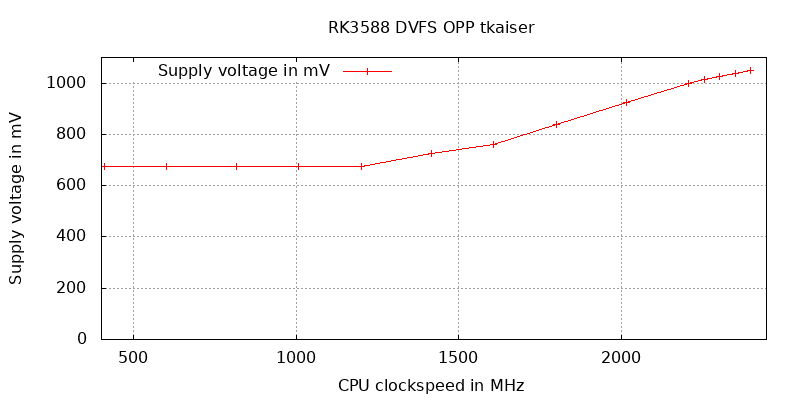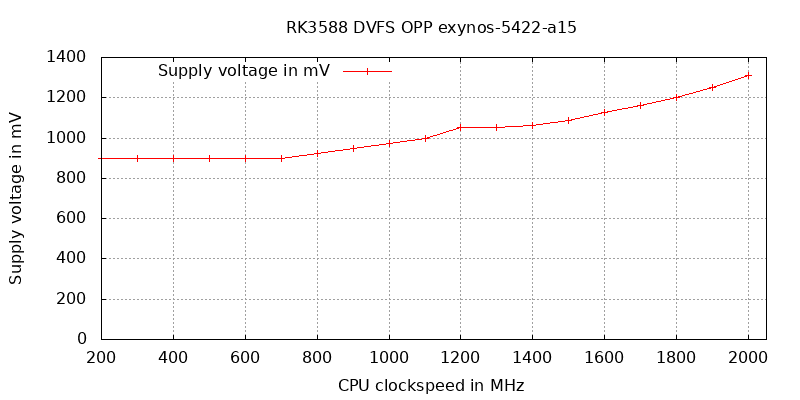Well, this is the memory OPP table as defined. Which is in conflict with /sys/devices/platform/dmc/devfreq/dmc/available_frequencies since there’s no 2750MHz entry but it ends at 2112 MHz: 528000000 1068000000 1560000000 2112000000
@willy: is there a way to determine from ramlat measurements DRAM clockspeeds? Every cpufreq governor switched to performance and then checking dmc’s available_frequencies:
root@rock-5b:/sys/devices/platform/dmc/devfreq/dmc# for i in $(<available_frequencies) ; do echo -e "\n$i\n"; echo $i >min_freq ; echo $i >max_freq ; taskset -c 5 /usr/local/src/ramspeed/ramlat -s -n 200 ; done
528000000
size: 1x32 2x32 1x64 2x64 1xPTR 2xPTR 4xPTR 8xPTR
4k: 1.706 1.706 1.706 1.706 1.706 1.706 1.706 3.234
8k: 1.706 1.706 1.706 1.706 1.706 1.706 1.706 3.325
16k: 1.706 1.706 1.706 1.706 1.706 1.706 1.706 3.325
32k: 1.706 1.706 1.706 1.706 1.706 1.706 1.706 3.329
64k: 1.707 1.707 1.707 1.707 1.707 1.707 1.707 3.328
128k: 5.149 5.146 5.144 5.146 5.144 5.853 7.185 12.92
256k: 5.982 6.163 5.970 6.165 5.965 5.991 7.497 12.90
512k: 8.734 8.199 8.603 8.201 8.626 8.408 9.332 14.92
1024k: 20.14 18.54 18.49 18.54 18.53 18.88 20.95 30.60
2048k: 25.87 20.83 21.94 20.82 21.96 22.34 25.41 38.82
4096k: 99.21 72.74 84.82 72.67 86.27 72.74 78.43 107.8
8192k: 178.6 158.7 173.2 158.9 172.7 153.4 159.3 182.4
16384k: 217.0 203.5 211.8 202.3 211.5 194.6 208.8 217.0
1068000000
size: 1x32 2x32 1x64 2x64 1xPTR 2xPTR 4xPTR 8xPTR
4k: 1.707 1.707 1.707 1.707 1.707 1.707 1.707 3.233
8k: 1.707 1.707 1.707 1.707 1.707 1.707 1.707 3.327
16k: 1.707 1.707 1.707 1.707 1.707 1.707 1.707 3.327
32k: 1.707 1.707 1.707 1.707 1.707 1.707 1.707 3.330
64k: 1.708 1.707 1.708 1.707 1.708 1.708 1.708 3.330
128k: 5.123 5.121 5.120 5.121 5.120 5.815 7.166 12.92
256k: 5.976 6.163 5.972 6.165 5.975 5.994 7.500 12.91
512k: 8.832 8.530 8.778 8.536 8.514 8.859 9.705 15.37
1024k: 18.62 18.56 18.51 18.56 18.68 18.90 20.98 30.61
2048k: 18.92 19.39 18.64 19.39 18.69 19.76 21.65 30.88
4096k: 71.60 52.61 62.12 52.40 63.17 54.66 58.07 77.36
8192k: 131.4 113.6 127.8 112.5 127.5 110.4 113.5 128.4
16384k: 160.9 147.5 157.4 147.3 157.4 142.9 147.7 152.7
1560000000
size: 1x32 2x32 1x64 2x64 1xPTR 2xPTR 4xPTR 8xPTR
4k: 1.707 1.708 1.707 1.707 1.707 1.707 1.708 3.237
8k: 1.707 1.708 1.707 1.708 1.707 1.707 1.708 3.328
16k: 1.707 1.708 1.707 1.708 1.707 1.708 1.708 3.329
32k: 1.708 1.708 1.707 1.708 1.707 1.708 1.708 3.332
64k: 1.709 1.708 1.708 1.708 1.708 1.708 1.709 3.331
128k: 5.152 5.150 5.149 5.150 5.149 5.824 7.197 12.93
256k: 6.011 5.996 6.004 5.996 6.004 6.008 7.518 12.92
512k: 8.634 8.240 8.814 8.265 8.105 8.374 9.551 15.25
1024k: 18.76 18.69 18.38 18.68 18.11 19.03 21.14 30.59
2048k: 18.73 19.26 18.50 19.26 18.55 19.55 21.59 30.85
4096k: 60.18 46.27 54.10 46.18 54.60 47.84 50.54 65.17
8192k: 108.3 92.29 102.9 91.68 103.6 91.60 94.70 105.9
16384k: 135.8 124.9 133.7 125.0 134.6 122.7 124.7 126.9
2112000000
size: 1x32 2x32 1x64 2x64 1xPTR 2xPTR 4xPTR 8xPTR
4k: 1.709 1.709 1.708 1.709 1.708 1.708 1.709 3.240
8k: 1.708 1.709 1.708 1.709 1.708 1.709 1.709 3.330
16k: 1.708 1.709 1.708 1.709 1.708 1.708 1.709 3.330
32k: 1.708 1.709 1.708 1.709 1.708 1.709 1.709 3.334
64k: 1.710 1.709 1.710 1.709 1.710 1.710 1.710 3.334
128k: 5.128 5.127 5.126 5.127 5.126 5.744 7.175 12.94
256k: 5.988 6.170 5.981 6.170 5.982 6.000 7.509 12.92
512k: 8.030 7.508 8.089 7.557 7.882 7.799 8.715 14.56
1024k: 18.44 18.58 18.36 18.57 18.96 18.89 20.95 30.58
2048k: 18.96 19.30 18.75 19.30 18.75 19.62 21.66 31.06
4096k: 54.45 42.41 49.72 42.30 49.29 43.93 46.23 59.35
8192k: 97.40 83.49 94.01 83.06 93.91 83.65 85.51 94.37
16384k: 123.9 115.1 122.0 115.1 122.1 112.8 113.8 115.5





